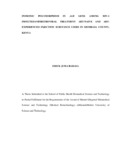INTRONIC POLYMORPHISM ALB GENE AMONG HIV-1 IN INFECTEDANTIRETROVIRAL TREATMENT ART-NAIVE AND ART- EXPERIENCED INJECTION SUBSTANCE USERS IN MOMBASA COUNTY, KENYA
Abstract
Injection substance use is both a social and public health concern. Globally, the co- burden of human immunodeficiency virus and injection substance use (HIV-ISU) is high especially in coastal urban and peri-urban region of Sub-Saharan Africa. Although, antiretroviral treatment (ART) has increased the quality of life in HIV-1 infected patients, injection substance use is detrimental to HIV-1 infected individuals.Injection substance user accelerate disease development ininjection substance users (ISUs)as well as the general population. Reduced circulation albumin levels is among the pathophysiological pattern of deregulated marker in injection substance user HIV-1 infected individuals. This is attributed to multi-interaction of injection substances, HIV-1 infection,and ARTas well as host genetics. The albumin gene expression is modulated through several mechanisms including intronic consensus elements. Thus, the current study investigated intron VII (C/G) polymorphism in the ALB gene (rs1445776009) and its associationwith circulating albumin levels, adiposity markers, immunosuppression and high density HIV-1 viremia. This cross sectional case control study was conducted at Bomu hospital Mombasa County, Kenya. The study participants were recruited using purposive and snowball sampling. A total of 155 ISUs were recruited into the study comprising of case (ART- experienced, n=93) and control (ART-naive, n=62). Apre-tested questionnaire was used to collect demographic and substance use profiles of study participants.Anthropometric measurements were taken by well-trained clinician. CD4 T cells were enumerated using an automated BD FACSCalibur flow cytometer, HIV-1 RNA copies were determined usingmechanized Abbott m2000 System and circulating albumin was measured usingprogrammed clinical chemistry analyzer (Roche COBAS® 6000).Intron VII rs1445776009 of the ALB gene was genotyped using polymerase chain reaction (PCR) restriction fragment length polymorphism (RFLP). Genotype frequency was similar, with wildtype, CC and heterozygous, CG genotype carriage most and least prevalent, respectively in the case (40.3 vs 26.9), control (59.7 vs 19.3) as well as general population (50.3 vs 23.9); (P=0.074). The alleles frequency was in line with Hard Weinberg equilibrium for both the ART-experienced, (P=0.178), ART-naive, (P=0.288) and the overall study population, (P=0.096). The mutant GG, geno type relative to
geno type carriage was associated with
wild type
high
odds
of
CC,
havinghypoalbuminemia(OR, 1.933; 95% CI, 1.524-4.664; P=0.033), underweight(OR, 2.412; 95% CI, 1.124-5.782; P=0.026), immunosuppression (OR, 3.036; 95% CI, 1.957- 9.633; P=0.021) and high density HIVviremia (OR, 1.836; 95% CI, 1.134-6.298; P=0.016), in the ART-experienced ISUs. These findings suggest that injection substance use and ART may modulate the ALB gene expression and subsequently influence HIV-1 disease outcomes. Indicating that,rs1445776009 polymorphism can be a good surrogate marker of disease outcomes in HIV-1 infected ISUs.

